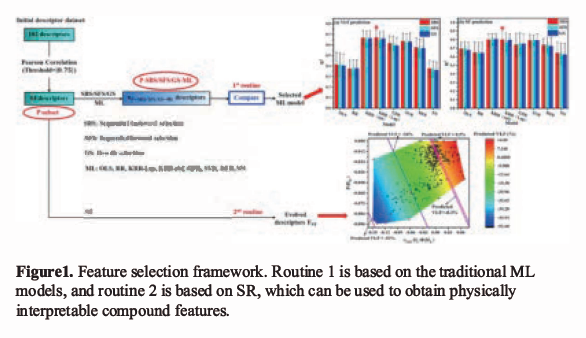Yuanxun Zhou1, Yongchao Rao1, Lanting Zhang1,2,3*, Shenghong Ju1,2, Hong Wang1,2,3*
1School of Materials Science and Engineering, Shanghai Jiao Tong University, Shanghai 200240, China
2Materials Genome Initiative Center, Shanghai Jiao Tong University, Shanghai 200240, China
3Shanghai Key Laboratory of High-Temperature Materials and Precision Forming, Shanghai Jiao Tong University, 800 Dong Chuan Road, Shanghai 200240, China
EXTENDED ABSTRACT: In binary substitutional metallic solid solutions (BSMSS), the volume effects (VE) can be characterized by two parameters: Vegard's law factor (VLF) and volume size factor (SF) [1]. However, due to the complex interaction between atoms, the present models and methods for calculating VLF and SF show certain problems such as poor prediction accuracy, unclear physical meaning and time-consuming. We have tried ML methods to model VLF and SF and compared them with the commonly used first-principles calculation.We first obtained a dataset containing 182 initial features and 409 entries from the literature, Then a model-building framework for feature selection was constructed as shown in Fig.1 according to the eight commonly used traditional ML models and symbol regression (SR).The ridge regression model based on the Laplacian kernel(KRR) was selected from the first routine,and new compound features could be evolved by SR in the second routine.Compared with the KRR model, this new feature gives an explicit expression, improving the interpretability of the model. The expression can be then interpreted as a physically meaningful 2D descriptor (lower right corner of Fig. 1). Case study of the Fe-based BSMSS shows that ML models exhibit higher R2 than that of density functional calculation, and provides reasonable results for systems without experimental results. The introduction of VLF and SF prediction ML models is helpful to clarify the electronic coupling effect refered to in previous studies. This may shed light to alloy design or VE-related theoretical studies, not only for binary metallic solid solution systems but also for higher-order alloys [2].
REFERENCES
[1] H.W. King, Quantitative size-factors for metallic solid solutions, Journal of Materials Science 1(1) (1966) 79-90.
[2] Y. Zhou, Y. Rao, L. Zh g, S. Ju, H. Wang, Machine-leaming prediction of Vegard's law factor and volume size factor for binary substitutional metallic solid solutions, Acta Materialia 237 (2022) 118166.


Yuanxun Zhou graduated from Xiangtan University with a bachelor's degree in applied chemistry. He graduated from the University of Electronic Science and Technology of China with a master's degree in materials science and engineering. Currently, he is a PhD candidate majoring in materials science and engineering at Shanghai Jiao tong University. His research intcrests are material informatics, high-throughput experiment and characterization of combinatorial alloy chips, and his supervisor is Professor Wang Hong.